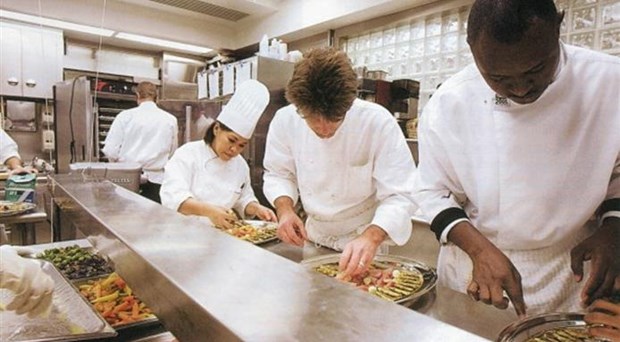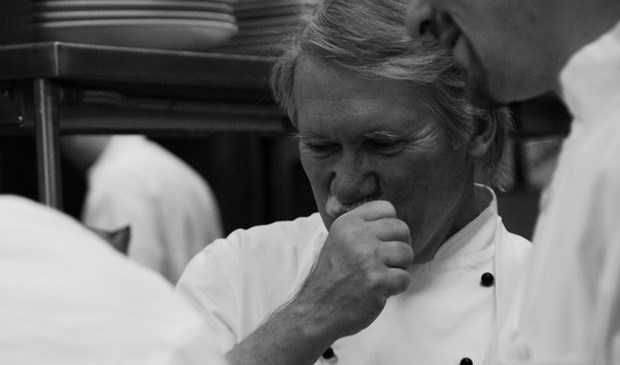Imagine
all the times you’ve gone into a restaurant, the atmosphere is great, the staff
are welcoming and informative, the decor is perfect and the menu reads well.
Only to discover once the first plate hits your table that the kitchen is
kicking out mediocre grub.
It’s
all too common in the industry and something that has caught the attention of
one of our favourite bloggers, Paul Sorgule.
Sorgule
is a chef with years of experience in the industry and someone who is happy to
dispense solid advice to anyone who wants it. In his latest post, The Chef is
Responsible, he speaks about the issue of restaurants falling short and
explains why he believes that it is down to the chef.
He
is also kind enough to explain how a chef can build the right skills to make
sure they deliver at the highest level.

© Photo Shealah Craighead
1. Competence
The
chef must be exceptional at what he or she does: a great cook, a balanced
manager, an inspiring leader, and a consummate communicator. A person cannot
possibly hold the position of chef (earned title) without owning these skills
and attributes.
2. Palate
In
the end, the food is all about flavour. The chef should have a well-developed,
vastly experienced palate and have the ability to build flavour profiles that
will set the restaurant apart.
3. Experience
By
the time a person reaches the level of chef, he or she should have matured as a
competent professional, having made most of the junior mistakes that are
expected of cooks and sous chefs. The position of chef is far less forgiving
than those positions held prior.
4. Knowledge of Food
The
chef should have an encyclopedic knowledge of food, the ingredients available,
the seasonality of those ingredients; the methods of cooking that are most
appropriate for those ingredients, and how to compensate, through solid
cooking, for any character flaws that might exist in those ingredients.
5. Respect
This
is a multifaceted attribute that requires the chef to respect ingredients,
staff, established methods of cooking, the customer and the business itself.

Chef Paul Sorgule (left). © Photo Harvest America Ventures
6. Menu Planning
A
menu, like a great novel, should be designed to tell a story with a strong
beginning, great character development, some intrigue and surprise, a message
that has staying power, and a conclusion or ending that keeps people guessing
and talking about the experience. When a menu is simply treated as a list of
random items that do not fit the story then there is little compelling reason
for people to invest in a return visit and even less reason for exiting
customers to become ambassadors.
7. Knowledge of Menu
Fit
The
kitchen cannot be separate from the rest of the experience. When designing the
menu, the chef must work with the location, the décor, the “feel” of the
operation, and most importantly understand the profile of the guest who is most
likely to support the operation.
8. Training
Once
the chef has established a supportive menu that tells an interesting story, he
or she must work diligently to test recipes and plate presentations until the
formula is just right. Then it is essential to teach and train both back and
front of house about the items, how they are prepared, why certain ingredients
are used, how the dish should taste and look, and then constantly monitor
everything to ensure that everyone adheres to the expectations.
9. Team Focus
In
an ideal situation, the well-trained team eventually becomes part of the menu
design process, networks with vendors and growers so that a connection is made
with the source, and learns to work together to reach common goals.
10. High Expectations
The
days of the temperamental, screaming chef are fading quickly, yet the
expectations for excellence that these chefs of old had for the work of the
kitchen must still be supported. Create an environment where every cook and
server has to work harder than they expected to produce and serve the
restaurant's food. You will soon see that they find it very difficult to waiver
from this commitment.

© Photo Harvest America Ventures
11. Weed Out the Weak
Links
Staffing
your restaurant doesn’t always work out as it should. Even with the right effort,
the best training, and the support that competent chefs provide, sometimes a
team member can’t or doesn’t want to cut it. Weed them out before they infect
the rest of the team.
12. Presence – Be The
Example
Respect
is earned and staff will be more inclined to carry out the chef’s vision if he
or she is ever-present, and investing in people, products, and results.
13. Sweat The Details
Everything
in the restaurant is important. With regard to the food it is essential that
the chef insist that each employee sweats the details. Whether it is the
preciseness of vegetable cuts, the right amount of time for a sauce reduction,
the grill marks on a steak, the care taken to properly fillet a fish, or the
methodical approach towards plating – the experience of the guest is impacted
by details.
14. Sign Each Plate
When
the chef knows that each plate leaving the kitchen carries his or her
signature, his or her reputation, and clearly states to the world the passion
and ability of the team, then the significance of detail really hits home.
15. The Position Is
Not About Power – It’s About Responsibility
Yes,
if anything goes wrong, it is the chef’s fault. On the other hand, whatever
goes right is a result of the chef setting the tone for the kitchen, selecting
and training the right staff, and being the example of excellence that others
respect and want to follow.
By FDL